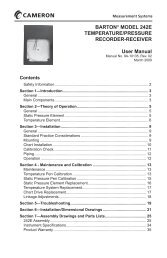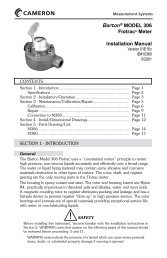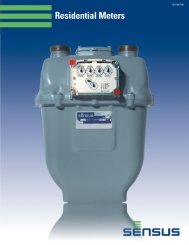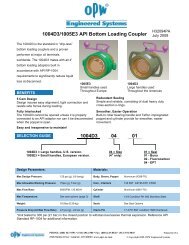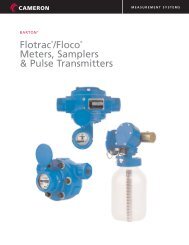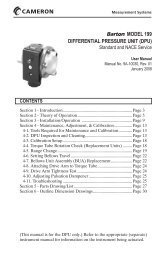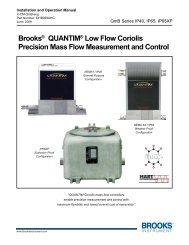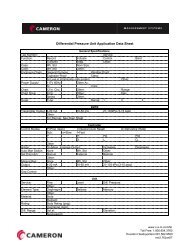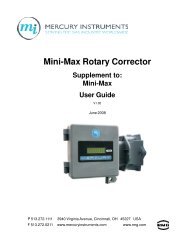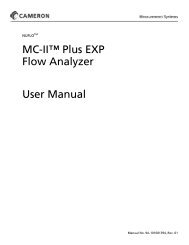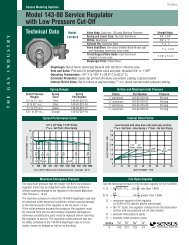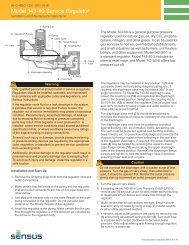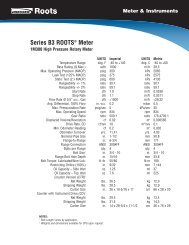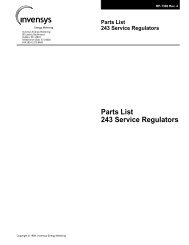Dresser Roots Model 5 Prover Manual - The Meter and Valve ...
Dresser Roots Model 5 Prover Manual - The Meter and Valve ...
Dresser Roots Model 5 Prover Manual - The Meter and Valve ...
- No tags were found...
You also want an ePaper? Increase the reach of your titles
YUMPU automatically turns print PDFs into web optimized ePapers that Google loves.
3. Ensure the pressure lines are properly connected from the Controller to the appropriate Master<strong>Meter</strong>. One end of the blue inlet Pressure Line will connect into the selected Master <strong>Meter</strong>’s inletpressure fitting <strong>and</strong> the other end connects into the inlet pressure port on the Controller(labeled IN PRESS). In a similar fashion, one end of the black outlet Pressure Line will connectinto the selected Master <strong>Meter</strong>’s outlet pressure fitting <strong>and</strong> the other end connects into the outletpressure port on the Controller (labeled OUT PRESS).Electrical power to the <strong>Model</strong> 5 <strong>Prover</strong> must be off.4. If not already factory connected, connect the Master <strong>Meter</strong> Cable to the appropriate Master<strong>Meter</strong> Junction Box for the Master <strong>Meter</strong> being used. Connect the other end of the Master <strong>Meter</strong>Cable to the connector labeled MASTER METER on the Controller. See page 3 <strong>and</strong> 4 for theMaster <strong>Meter</strong>s <strong>and</strong> their attached Junction Boxes.5. Connect the 12 pin Field <strong>Meter</strong> Junction Box cable connector to the mating 12 pin connectorlabeled FIELD CABLE on the Controller.6. Install the P&T (Pressure & Temperature) Adapter into the inlet pressure port for rotary <strong>and</strong>diaphragm meters <strong>and</strong> at the outlet pressure port for turbine meters.7. Install the Field <strong>Meter</strong> Pressure Adapter into the outlet pressure port of the Field <strong>Meter</strong>for rotary <strong>and</strong> diaphragm meters.8. Insert the Field <strong>Meter</strong> Temperature Probe into the P&T Adapter’s vertical port until theTemperature Probe is in the center of the air stream - then h<strong>and</strong> tighten the compression fitting.If installing the P&T Adapter into the top of a diaphragm meter, do not to extend the probe tothe point where it will engage with the tangent linkage. If opening is not available, install probe inthe pipe line as close to meter outlet as possible.Make sure that the Field <strong>Meter</strong> Temperature Probe or the meter being tested cannot be damaged due tothe positioning of the Field <strong>Meter</strong> Temperature Probe. Avoid leakage at or around the P&T Adapter orField <strong>Meter</strong> Temperature Probe.9. Plug the end of the Field <strong>Meter</strong> Temperature Probe cable into the Field <strong>Meter</strong> Junction Boxconnection labeled TEMP. <strong>The</strong> Field <strong>Meter</strong> Junction Box is shown in on page 3 <strong>and</strong> 4.Figure 2: Instrument Drive Pulser test set-up.19



